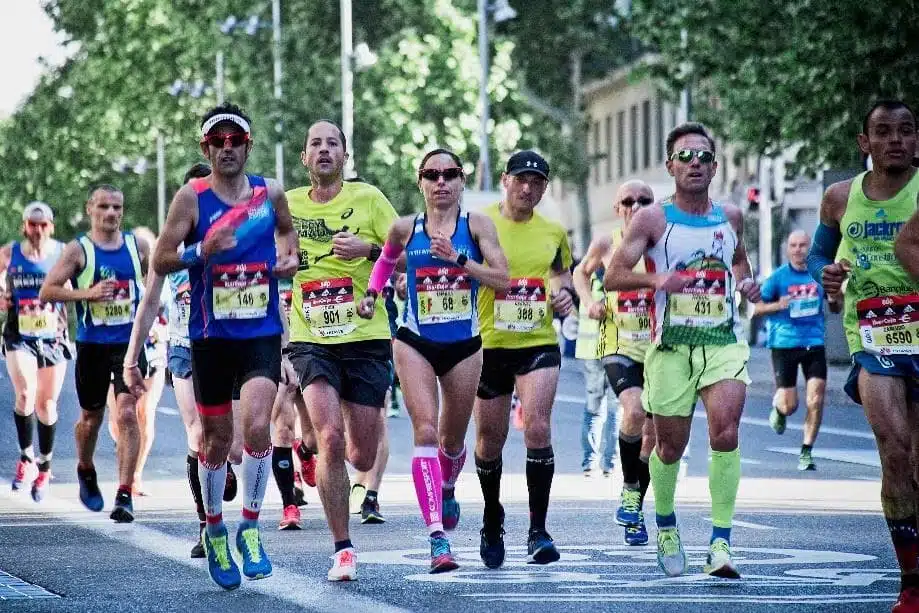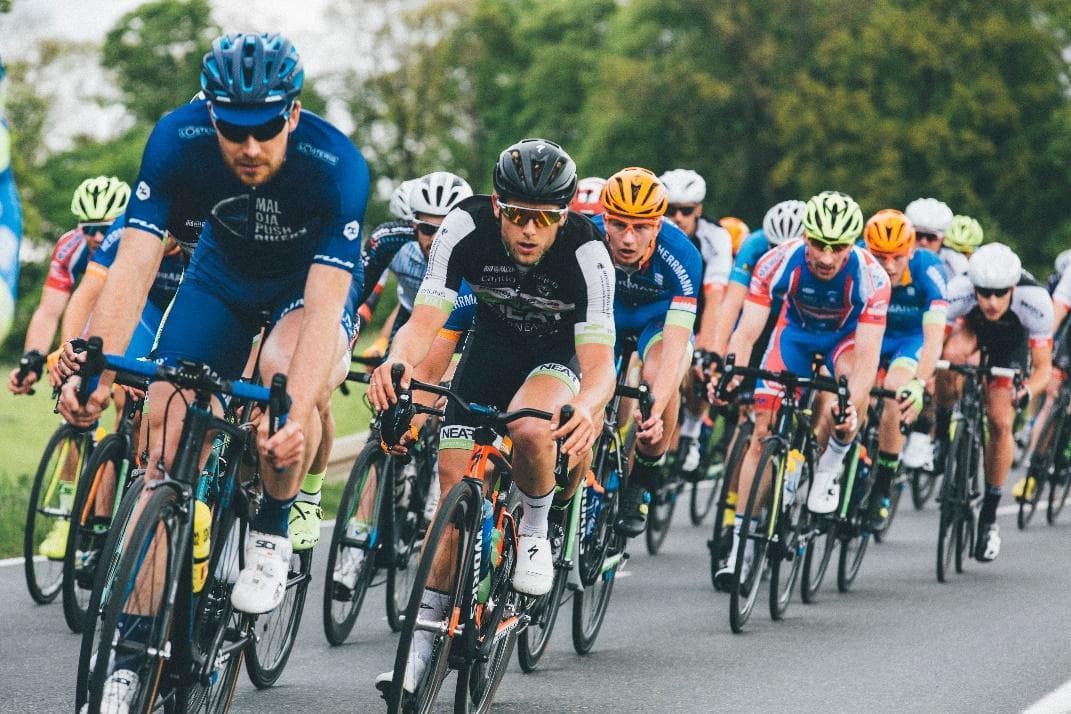8 de October de 2022
Pros and Cons of Carbohydrate Loading
What is hydrate loading?

Carbohydrates are the main source of energy during physical exercise, especially if it is of a certain intensity (Cermak & Van Loon, 2013). These carbohydrates are stored in our body in the form of glycogen (Adeva-Andany, González-Lucán, Donapetry-García, Fernández-Fernández, & Ameneiros-Rodríguez, 2016). The main glycogen stores are the liver (approximately 80 to 120g) and muscles that accumulate approximately 350 to 700g of glycogen (Knuiman, Hopman, & Mensink, 2015).
Carbohydrate loading is a strategy for storing the most glycogen in the liver and muscle. In this way we can improve athletic performance in long-term endurance tests (Jeukendrup, 2011). The goal of carbohydrate loading is to increase the amount of stored energy so that it can be used by the muscles throughout the athletic event.
Carbohydrate loading is also used by bodybuilders to increase muscle circumference size and photographic silhouette scores in competition (Chappell & Simper, 2018). Thanks to this strategy, changes in muscle thickness can be observed in the different muscle circumferences (calf, biceps …), which improves subjective physical appearance. If you follow bodybuilding you may have heard an athlete talking about loading and unloading in the days before the competition, or that they are more or less “flat”. The goal of carbohydrate loading in bodybuilding is to avoid that “flat” view of muscles and achieve a larger, rockier appearance (de Moraes et al., 2019).
How is carbohydrate loading done?
Carbohydrate loading is done by consuming a diet high in carbohydrates while reducing training in the days leading up to the event. Depending on the days of separation between the start of the carbohydrate load and the sporting event we will carry out one protocol or another. In some carbohydrate loading strategies, an initial depletion phase occurs to cause supercompensation later by increasing the amount of carbohydrates. However, other researchers report that this phase is not necessary, so it will be up to personal choice to do it or not (Bussau, Fairchild, Rao, Steele, & Fournier, 2002).
Most common carbohydrate loading types in endurance tests

The loading phase is similar in all strategies that are commonly used with this goal of saturating glycogen stores. On loading days 70% of the diet should come from carbohydrates. If we make the intake based on body weight, the scientific literature reports a wide range of between 5 and 12 grams per kilo of weight and day in the loading phase (Jeukendrup, 2011). Experts narrow this range a little more and place it between 8 and 12g per kilo (Jeukendrup, 2011; Kerksick et al., 2022), with 10g per kilo of weight per day being the recommended generic base (Bussau et al., 2002).
The data in the previous paragraph are the same in the different endurance sports protocols that we will see below. When we talk about “carbohydrate recommendations established in the loading phase”, we will refer to such data. These are the most common types of carbohydrate loading in endurance tests:
Six-day carbohydrate loading strategy with glycogen depletion phase (Bergström, Hermansen, Hultman, & Saltin, 1967): we will perform a first phase of three days to empty glycogen stores, followed by a second phase of three days to perform a supercompensation of these stores. The first three days we will continue training and carbohydrates will be only 15% of total calories. From day four to the test we will consume the carbohydrate recommendations established in the loading phase.
Six-day carbohydrate loading strategy without glycogen depletion phase: in this case the first three days there will not be such a sharp decrease in carbohydrate consumption, this being 50% of the total calories in the diet. From day four to the test we will carry out carbohydrate recommendations established in the loading phase. Regarding physical exercise, we will decrease the amount, being practically null from day four to the sporting event.
Three-day carbohydrate loading strategy with or without glycogen depletion (Fink & Mikesky, 2020; Kerksick et al., 2022): This strategy is the most common and probably the most effective in stress testing. Withthis type of carbohydrate load we skip the first three days of the six-day models, and go straight to the three days before the test. A first option is to start the three days of loading with a very demanding session that considerably reduces glycogen stores. The second option deletes that session. The rest is identical in both cases, following the carbohydrate recommendations established in the loading phase in the three days prior to the event and eliminating training.
One-day carbohydrate loading strategy (Bussau et al., 2002): it is the simplest of all. It consists of consuming the carbohydrate recommendations established in the loading phase and not doing physical exercise the day before the sporting event.
Most Common Carbohydrate Loading Types in Bodybuilding

Six-day carbohydrate loading strategy with glycogen depletion phase: consists of three days of carbohydrate depletion with an intake of less than 2g per kilo of weight per day and the following three days with a high carbohydrate intake (8 to 12g per kilo of weight per day). This is the classic loading protocol in bodybuilding (de Moraes et al., 2019). The first three days we train to help empty glycogen stores, but the next three we will limit or completely cancel the training, thus favoring the carbohydrate load.
Carbohydrate loading strategy of four or five days without glycogen depletion: in this case there is not as low a carbohydrate intake as in the previous type of load. The first three days are of moderate carbohydrate intake (about 5 grams per kilo of weight per day), ending the strategy with a period of 24 – 48h of high carbohydrate intake (8-12g per kilo of weight and day) (Burke, Van Loon, & Hawley, 2017). Training is limited in the two or three days prior to the competition to take advantage of that load of carbohydrates, since when training we would be using this macronutrient and it would not be beneficial when storing it.
Aspects to take into account when making a hydrate load

Foods from a carbohydrate load
In the carbohydrate loading phase we must select foods that we have already eaten before to avoid surprises on the most important days of the competition. The ideal is to test when we do not have an important competition nearby, and if everything goes well, replicate it when that event arrives.
In these load phase tests we will also have to try foods rich in carbohydrates and low in fiber (sports drinks, juices, low-fiber cereals, white bread, white rice and energy bars low in fat and fiber) and with foods rich in carbohydrates and fiber (whole grains, legumes, wholemeal bread or pasta, vegetable, fruit). Ideally, a dietitian-nutritionist advises us according to our familiarization with the consumption of carbohydrates and establishes a diet that incorporates foods high and low in fiber (Burke, Hawley, Wong, & Jeukendrup, 2011).
For which events is a load of hydrates recommended?
Carbohydrate loading is appropriate in endurance tests that consume stored glycogen, such as cycling, running, rowing, etc. of about 90 minutes or more (Bergström et al., 1967). In this type of physical exercise there is a decrease in performance if we do not manage glycogen levels before and during the test (Hawley, Schabort, Noakes, & Dennis, 1997). In endurance tests of shorter duration or lower glycogen consumption it is not necessary to carry out a carbohydrate load.
For strength tests such as powerlifting championships, it is not necessary to do a load of carbohydrates, but it is necessary to have adequate levels of glycogen, just as we need them in daily workouts. In this type of tests, as in short-term resistance, the available glycogen reserves will be far from exhausted, so they will not be a limiting factor of performance, an aspect that does happen when there is a continuous use of glycogen in tests of more than 90 minutes (Mata et al., 2019).
In bodybuilding or when we have an important photo shoot in which our muscles have to stand out, it is also effective to perform a load of hydrates. By carrying out this strategy our subjective appearance will improve, thus achieving better muscle circumferences and higher quality muscle exposure (de Moraes et al., 2019).
Advantages and disadvantages of carbohydrate loading

Advantage: astore full of glycogen gives better physical and aesthetic performance
A carbohydrate load can increase glycogen levels stored in muscles to twice their normal capacity (Adeva-Andany et al., 2016). The higher our glycogen stores, the longer it will be until they are emptied. During the endurance race, carbohydrates are reintroduced to avoid this emptying, since this delays fatigue. Therefore, it is vital to have adequate levels of glycogen already from the starting line to prevent the onset of fatigue and thus achieve a better mark in cross-country sports .
In bodybuilding, full glycogen deposits in the muscle will make the muscles not “flat” but “full”, thus giving a better aesthetic appearance. Not taking into account the load of hydrates in this discipline can make us go out on stage with a worse physique, thus losing options to climb positions in the competition.
Drawback: possible gastrointestinal and mental upset
Fiber is beneficial to health, but in adequate amounts. By significantly increasing the consumption of carbohydrate-rich foods in a load, fiber intake can skyrocket. A very high or very low intake of fiber can cause gastric discomfort in quite a few people, causing constipation or diarrhea (Fink & Mikesky, 2020). Therefore, in these days of loading we must select foods with which we are familiar and choose the type of food well.
Constipation may reflect reduced fiber intake, but too much fiber can slow stool transit time and water accumulation. Bodybuilders typically exhibit reduced constipation and increased diarrhea scores (de Moraes et al., 2019). To avoid this, we must plan the diet with a professional who tells us how to do it, since both food, and moving very quickly from a diet very low in carbohydrates to a very high one, increases gastrointestinal symptoms (Jeukendrup, 2017).
Some people, especially bodybuilders, find carbohydrate loading very stressful (Mitchell, Hackett, Gifford, Estermann, & O’Connor, 2017). The combination of stress from competition, coupled with a drastic increase in the amount of food they must eat, can lead to an alteration of mood, especially if the load is accompanied by gastrointestinal discomfort.
Drawback: physical changes
In the loading phase we can feel several physical changes such as swelling due to water retention and heaviness from ingesting many carbohydrates. If we are professionals who dedicate ourselves exclusively to our sport there will be no greater problem than spending two or three days with these changes. However, it can be expensive to perform our professional tasks these days with that bloating and lethargy. Quite possibly you have been suddenly tired after finishing a hearty plate of pasta, right? Well, that feeling would be similar to what we have in a load of hydrates for several days.
The change of weight in resistance does not have major importance since we do not compete in different categories according to our weight. For bodybuilders it should be taken into account since, depending on their weight, they will compete in one category or another, which can hinder the loading phase.
Conclusions
Carbohydrate loading is a strategy for storing the most glycogen in the liver and muscle. Tanks full of this energy will give us greater performance in endurance tests and a better physical appearance in bodybuilding competitions. There are different protocols that we must carry out, but they all have a similarity: a few days after the competition we raise the consumption of carbohydrates to 70% of the calories of the diet or about 10g per kilo of weight and day.
When loading carbohydrates there are some drawbacks that we must know and control. There is a possibility of gastric discomfort, irritability and physical changes, but they can be controlled. In addition, improved physical and aesthetic performance make hydrate loading necessary for athletes of distance races of 90 minutes or more, as well as bodybuilders.
Joaquin Vico Plaza
References
Adeva-Andany, M. M., González-Lucán, M., Donapetry-García, C., Fernández-Fernández, C., & Ameneiros-Rodríguez, E. (2016). Glycogen metabolism in humans. BBA Clinical, 5, 85–100. https://doi.org/10.1016/J.BBACLI.2016.02.001
Bergström, J., Hermansen, L., Hultman, E., & Saltin, B. (1967). Diet, muscle glycogen and physical performance. Acta Physiologica Scandinavica, 71(2), 140–150. https://doi.org/10.1111/J.1748-1716.1967.TB03720.X
Burke, L. M., Hawley, J. A., Wong, S. H. S., & Jeukendrup, A. E. (2011). Carbohydrates for training and competition. Https://Doi.Org/10.1080/02640414.2011.585473, 29(SUPPL. 1), 17–27. https://doi.org/10.1080/02640414.2011.585473
Burke, L. M., Van Loon, L. J. C., & Hawley, J. A. (2017). Postexercise muscle glycogen resynthesis in humans. Journal of Applied Physiology (Bethesda, Md. : 1985), 122(5), 1055–1067. https://doi.org/10.1152/JAPPLPHYSIOL.00860.2016
Bussau, V. A., Fairchild, T. J., Rao, A., Steele, P., & Fournier, P. A. (2002). Carbohydrate loading in human muscle: an improved 1 day protocol. European Journal of Applied Physiology, 87(3), 290–295. https://doi.org/10.1007/S00421-002-0621-5
Cermak, N. M., & Van Loon, L. J. C. (2013). The use of carbohydrates during exercise as an ergogenic aid. Sports Medicine (Auckland, N.Z.) , 43(11), 1139–1155. https://doi.org/10.1007/S40279-013-0079-0
Chappell, A. J., & Simper, T. N. (2018). Nutritional Peak Week and Competition Day Strategies of Competitive Natural Bodybuilders. Sports (Basel, Switzerland), 6(4). https://doi.org/10.3390/SPORTS6040126
de Moraes, W. M., de Almeida, F. N., Dos Santos, L. E. A., Cavalcante, K. D. G., Santos, H. O., Navalta, J. W., & Prestes, J. (2019). Carbohydrate Loading Practice in Bodybuilders: Effects on Muscle Thickness, Photo Silhouette Scores, Mood States and Gastrointestinal Symptoms. Journal of Sports Science & Medicine, 18(4), 772. Retrieved from /pmc/articles/PMC6873117/
Fink, H. H., & Mikesky, A. E. (2020). Practical applications in sports nutrition.
Hawley, J. A., Schabort, E. J., Noakes, T. D., & Dennis, S. C. (1997). Carbohydrate-loading and exercise performance. An update. Sports Medicine (Auckland, N.Z.) , 24(2), 73–81. https://doi.org/10.2165/00007256-199724020-00001
Jeukendrup, A. E. (2011). Nutrition for endurance sports: marathon, triathlon, and road cycling. Journal of Sports Sciences, 29 Suppl 1(SUPPL. 1). https://doi.org/10.1080/02640414.2011.610348
Jeukendrup, A. E. (2017). Training the Gut for Athletes. Sports Medicine (Auckland, N.Z.) , 47(Suppl 1), 101–110. https://doi.org/10.1007/S40279-017-0690-6
Kerksick, C. M., Arent, S., Schoenfeld, B. J., Stout, J. R., Campbell, B., Wilborn, C. D., … Antonio, J. (2022). International society of sports nutrition position stand: nutrient timing. Https://Doi.Org/10.1186/S12970-017-0189-4, 14(1). https://doi.org/10.1186/S12970-017-0189-4
Knuiman, P., Hopman, M. T. E., & Mensink, M. (2015). Glycogen availability and skeletal muscle adaptations with endurance and resistance exercise. Nutrition & Metabolism, 12(1). https://doi.org/10.1186/S12986-015-0055-9
Mata, F., Valenzuela, P. L., Gimenez, J., Tur, C., Ferreria, D., Domínguez, R., … Sanz, J. M. M. (2019). Carbohydrate Availability and Physical Performance: Physiological Overview and Practical Recommendations. Nutrients 2019, Vol. 11, Page 1084, 11(5), 1084. https://doi.org/10.3390/NU11051084
Mitchell, L., Hackett, D., Gifford, J., Estermann, F., & O’connor, H. (2017). Do Bodybuilders Use Evidence-Based Nutrition Strategies to Manipulate Physique? Sports (Basel, Switzerland), 5(4). https://doi.org/10.3390/SPORTS5040076

